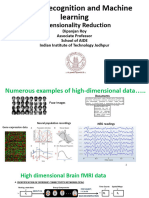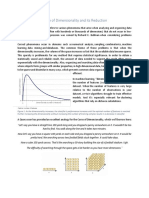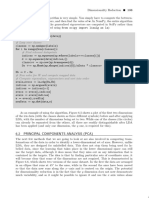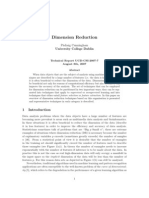0% found this document useful (0 votes)
122 views5 pagesLecture08 Notes
1) The document discusses dimensionality reduction techniques for MNIST image data. It finds that some pixels have zero variance and don't contribute useful information, allowing dimensionality to be reduced from 784 to 609 pixels.
2) Analyzing pixel variances cumulatively shows that around 75% of the variance can be explained by just 500 pixels, suggesting further dimensionality reduction may be possible by finding correlations between pixels.
3) The document introduces random projections as a simple and computationally efficient linear method to find a lower dimensional representation of the data that preserves its intrinsic structure and variations.
Uploaded by
chelseaCopyright
© © All Rights Reserved
We take content rights seriously. If you suspect this is your content, claim it here.
Available Formats
Download as PDF, TXT or read online on Scribd
0% found this document useful (0 votes)
122 views5 pagesLecture08 Notes
1) The document discusses dimensionality reduction techniques for MNIST image data. It finds that some pixels have zero variance and don't contribute useful information, allowing dimensionality to be reduced from 784 to 609 pixels.
2) Analyzing pixel variances cumulatively shows that around 75% of the variance can be explained by just 500 pixels, suggesting further dimensionality reduction may be possible by finding correlations between pixels.
3) The document introduces random projections as a simple and computationally efficient linear method to find a lower dimensional representation of the data that preserves its intrinsic structure and variations.
Uploaded by
chelseaCopyright
© © All Rights Reserved
We take content rights seriously. If you suspect this is your content, claim it here.
Available Formats
Download as PDF, TXT or read online on Scribd
/ 5





















































































